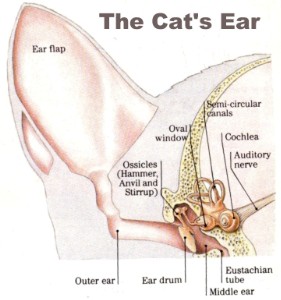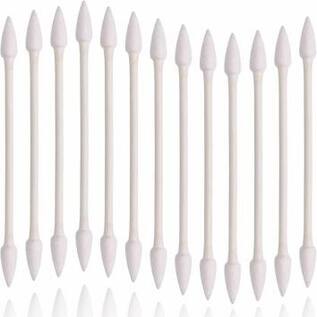Highland Lynx Cat Ear Care
The curled ears of the Highland Lynx require regular cleaning. Every cat is different. Some can be cleaned weekly, some need to be done every other day. You will need to master how often your cat needs his/her ears done. I recommend starting out every few days and stretching it out a day at a time until you know your cats requirements. The ear canals are more narrow and flattened than straight ears and can become infected with bacteria, yeast, wax or ear mites.
I also highly recommend these makeup swabs because they are more narrow and pointed. (click to go to amazon) Swabs. If your kitten/cats ears are bad, you will need to have a vet check them for ear mites. He/she may also prescribe antibiotics to help clear up an infection. Most vets will want to see that the ear drum is not damaged, but if it is clogged up, they will not be able to see it. You do not want your cats ear drum to be damaged and place a liquid in it, because it can cause severe damage.
I also highly recommend these makeup swabs because they are more narrow and pointed. (click to go to amazon) Swabs. If your kitten/cats ears are bad, you will need to have a vet check them for ear mites. He/she may also prescribe antibiotics to help clear up an infection. Most vets will want to see that the ear drum is not damaged, but if it is clogged up, they will not be able to see it. You do not want your cats ear drum to be damaged and place a liquid in it, because it can cause severe damage.
Regular ear care is one of the most overlooked areas of cat health. If the ear is sore or infected or if the cat is shaking its head or scratching at the ear, have him/her examined by a veterinarian. Ear mites are a common cause of ear infections in young cats and your veterinarian may recommend a treatment.
There are right ways and wrong ways to inspect and clean cats' ears. While most cats actually tolerate routine cleanings very well, these are a few tips that will work on most cats, including the toughest old Toms.
First and foremost, make regular ear cleaning part of your routine. If you inspect and clean your cat's ears on a weekly basis from the time he/she is 8 weeks old, it will become a routine part of life and he/she won't fight you when you start handling the ears.
Make it a positive experience! This sounds simple but it's the step that most people forget. Use treats like Liver Bites or Tuna Flakes during and after the cleaning to keep the experience positive. Also pet the cat to make him/her comfortable.
Hold the tip of the ear between your thumb and forefinger and gently roll it up so you can visualize the inner part of the ear. If the cat tries to get away, you can use your remaining three fingers to gently hang on to the loose skin on the back of its neck. If needed you can wrap you cat/kitten up in a towel to restrain the legs.
Examine the ear for redness, or discharge. Light brown wax is O.K., but black, red, or infected-looking discharges (e.g. yellow or green pus) indicate a problem. Gently wipe the inside of the ear with a wet wash towel or wet wipe first.
A q-tip must be used with great care if any debris is already in the ear. Please feel free to contact me if you need help with the correct way of doing this. Clean the upper portion first. Second use a scooping motion at the beginning of the ear canal to start removing debris. If you see even a tiny drop of blood, you must stop and repeat in two days.
Continue to clean the ear every other day to allow healing. If the ears are bad, it will take up to a month to clear.
Routine ear exams are important when it comes to ear problems, an ounce of prevention is worth a pound of cure, so make routine ear exams and cleanings part of your cat's weekly routine. If you are unable to care for the ears, please seek the help of a Veterinarian.
There are right ways and wrong ways to inspect and clean cats' ears. While most cats actually tolerate routine cleanings very well, these are a few tips that will work on most cats, including the toughest old Toms.
First and foremost, make regular ear cleaning part of your routine. If you inspect and clean your cat's ears on a weekly basis from the time he/she is 8 weeks old, it will become a routine part of life and he/she won't fight you when you start handling the ears.
Make it a positive experience! This sounds simple but it's the step that most people forget. Use treats like Liver Bites or Tuna Flakes during and after the cleaning to keep the experience positive. Also pet the cat to make him/her comfortable.
Hold the tip of the ear between your thumb and forefinger and gently roll it up so you can visualize the inner part of the ear. If the cat tries to get away, you can use your remaining three fingers to gently hang on to the loose skin on the back of its neck. If needed you can wrap you cat/kitten up in a towel to restrain the legs.
Examine the ear for redness, or discharge. Light brown wax is O.K., but black, red, or infected-looking discharges (e.g. yellow or green pus) indicate a problem. Gently wipe the inside of the ear with a wet wash towel or wet wipe first.
A q-tip must be used with great care if any debris is already in the ear. Please feel free to contact me if you need help with the correct way of doing this. Clean the upper portion first. Second use a scooping motion at the beginning of the ear canal to start removing debris. If you see even a tiny drop of blood, you must stop and repeat in two days.
Continue to clean the ear every other day to allow healing. If the ears are bad, it will take up to a month to clear.
Routine ear exams are important when it comes to ear problems, an ounce of prevention is worth a pound of cure, so make routine ear exams and cleanings part of your cat's weekly routine. If you are unable to care for the ears, please seek the help of a Veterinarian.
Highland Lynx Nail Care
I recommend reading the following article to help with trimming nails. I highly recommend using human nail clippers. The whole process takes no more than 60 seconds. Keeping your cats nails trimmed with make both you and your cat happy.
https://www.aspca.org/pet-care/cat-care/nail-trimming-101
https://www.aspca.org/pet-care/cat-care/nail-trimming-101


